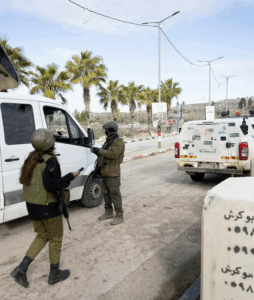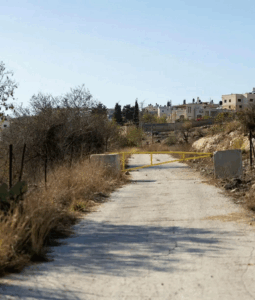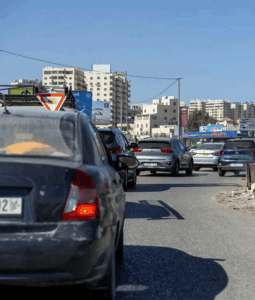‘Time is being stolen from us’: How IDF checkpoint expansion strangles Palestinian lfe in the West Bank

An IDF checkpoint at the exit to the Palestinian town of Turmus Ayya, in the West Bank near Ramallah
Amira Hass writes in Haaretz on 6 November 2025:
Guests have been invited to celebrate the good news: The results of their friend Lina’s medical test were negative. The cancer has not returned. Between glasses of red wine and talk of late-season mulukhiyah and methods of preparing it, the host told her guests the examination was pushed forward and why: Another person who had an appointment couldn’t make it, because they were stuck between roadblocks and checkpoints.
Originally, Lina (an alias, as are the names of other interviewees in this story) was scheduled to undergo the examination only at the end of the year, but the hospital in Ramallah put her on the waiting list for two different dates: Experience teaches that due to surprise roadblocks – or unusually slow soldiers at the checkpoints during morning rush hour, or simply due to a military raid on some neighborhood or village – somebody does not show up. On the first date, there were no cancellations.
About two weeks later, when she was fasting again, the hospital called her just before 10 A.M. and told her to come immediately. “We were happy, of course, but we also sympathized with the frustration and worry of someone whom we don’t know, and who could not make it,” says Lina and her companion.
And who better than them to know that it is dangerous to miss a PET-CT scan like the one Lina underwent. The machine in Ramallah (one of only two in the West Bank) can only test between eight and 10 people per day. The examination requires radioactive material, which is purchased in Israel. The material is brought to the hospital in the exact quantities required for that day’s scans, Lina’s doctor told her. Since most people who take the test are not from Ramallah, the consideration of Israel’s restrictions on movement also hovers over how the list is made.
There are 877 checkpoints and roadblocks spread between and around Palestinian enclaves in the West Bank (known as Areas A and B), according to documentation and a tally from the UN Office for the Coordination of Humanitarian Affairs. About one-quarter of those – 220 – have been placed since October 2023. Between February and September of this year, OCHA counted 28 new roadblocks. A similar survey by the Palestinian Colonization and Wall Resistance Commission done in September found 911 roadblocks, 80 of which have been set up since early 2025. This slight discrepancy indicates the multitude of the roadblocks, how widespread they are and the spontaneity with which they are set up – so the answer sometimes depends on the day.

A gate blocking residents’ access to their agricultural land in al-Janiya, west of Ramallah
In addition, there are also surprise pop-up roadblocks, where soldiers stand for an hour or two between villages or at the entrance, stopping every car and examining Palestinian drivers’ and passengers’ IDs, sometimes also photographing them. Their location varies, but the practice remains the same. Such was the case this Sunday (November 2), when 17 surprise roadblocks popped up, 11 of them in the Ramallah district. According to data from the PLO Negotiations’ department, 495 pop-up checkpoints appeared in September – with similar numbers recorded in previous months.
These various roadblocks actually delineate the artificial outlines of the A and B Palestinian territorial “pockets,” which make up 40 percent of the West Bank. All of them keep Palestinians away – or exclude them entirely – from the fastest and most direct roads inside the West Bank, used primarily by Israelis. Thus drives become longer and sometimes, all traffic comes to a standstill. Uncertainty is a constant factor in every trip.
A game of road closures
While waiting for her check-up, Lina met a young woman, a cancer patient, who lives in a village south of Nablus. She could have received chemotherapy at Al-Najah University Hospital in Nablus – a quarter-hour away from her home, in normal times. However, ever since October 2023, the southern entrance to Route 60 (the main thruway) to Nablus is blocked and barred (known as the Hawara checkpoint). For her, the road to Ramallah isn’t shorter, only slower.
Like many other Palestinians, Abu Nihad suspects that the real reason for blocking the roads at certain hours is that the soldiers are ordered to keep the main road clear for Israeli vehicles, to reduce their morning and afternoon traffic jams.
If the Hawara checkpoint is notorious for being closed, there are also the iron gates where soldiers play “open-and-close” with no clear rule of thumb – certainly not from the perspective of the Palestinians. In other words, many can only guess which of the possibilities will occur: The soldiers won’t be there, and the gate will be open; the soldiers will be absent, but the gate will be closed; the soldiers will be there, and the gate will be closed; or, the soldiers will be there, and the gate will be open, but they will stop and gaze at drivers with a slowness that seems to be deliberate. But even an open gate can lead to an encounter with a closed gate later on – or just a traffic jam created by the musical chairs game of road closures and forced detours through villages on narrow streets that are not intended for intercity travel.
“Tell her how many speed bumps you drive over every day,” Abu Nihad, a taxi driver around Ramallah, says to his friend, who drives on the Tulkarm line. Rather than taking the Nablus-Anabta road, which is blocked by the Einav checkpoint, he has been maneuvering around the streets of nearby villages and on dirt and gravel roads. “Sometimes, I pass through a checkpoint going one way, and traffic is flowing as usual,” recalls Abu Nihad. “When I come back 10 minutes later, it is closed and I have to bypass it or wait 30 minutes for it to reopen.”
He means, for example, the Atarah-Birzeit checkpoint north of Ramallah, which connects to the road between settlements of Neveh Tzuf and Ateret. Or the Jaba checkpoint, southeast of the city, on the outskirts of Route 60, which is jammed up with cars going to Jerusalem from nearby settlements – such as Eli and Shiloh, Ofra and Adam, and the outposts in between.
Abu Nihad views these delays as humiliation. Like many other Palestinians, he suspects that the real reason for blocking the roads at certain hours is that the soldiers are ordered to keep the main road clear for Israeli vehicles, to reduce their morning and afternoon traffic jams. “It’s not just humiliating,” adds Lina. “With every drive – or every decision not to drive – I feel like time is being stolen from us.”
Just how much time has been stolen was quantified by the Palestine Economic Policy Research Institute (MAS) in a recent study, which Haaretz viewed the final results of last month. Based on a sample of 100 public transportation vehicles that were on the road for most of the day over five days in October 2023, every short internal trip within the Nablus district itself involved an average delay of 23 minutes due to the checkpoints and blockades. This is compared to travel during “regular days” (that is, before the war).
A ride to and from Jericho involved 43 lost minutes, while for drives from Nablus to the central or southern West Bank, that figure was about one hour. But the scope of lost time becomes clear when one looks at the overall picture: According to the same research, 191,146 work hours are lost every single day to checkpoints and roadblocks. These lost hours cost the Palestinian economy some $764,600 (2.5 million shekels) a day, or some $16.8 million per month, as calculated by MAS researchers Tareq Sadeq and Ahmad Alawaneh.

Traffic jams caused by IDF checkpoints and roadblocks, October 2025
These costs, however, stem not only from the waiting, but also from attempts to bypass it. Drivers who prefer to find alternative routes are spending more on gas – and the cost of this daily additional expenditure amounts to some $19,200, accumulating to about $6 million per year.
Every driver feels this firsthand. Abu Nihad no longer bothers to calculate his losses precisely; he only counts the reasons for them. People travel less; waiting at the checkpoint wastes more diesel than the actual drive; the tires wear out faster on dirt and gravel roads; vehicle breakdowns are more frequent; the bypass routes also guzzle more diesel. “Sometimes,” he says, “we come back home having earned only 20 shekels per day.”
No money for travel
Lina learned from her doctor that one of his patients, who lives north of Ramallah, stopped coming in for treatment. When he called her up to ask why, she said couldn’t afford public transportation and that she would rather save the little she has to feed her children. He sent her money to cover travel expenses during treatment’s three-month duration – but she gave it to her children.
When there is gridlock at Qalandiyah checkpoint, you can complain about the increase in private cars and the consumer culture and forget that three lanes converge into one checkpoint, and that the checkpoints really separate Palestinians from Palestinians.
Avoiding travel is a general phenomenon and is only one of the symptoms of the economic crisis in the West Bank; tens of thousands of families lost their main source of livelihood when Israel banned the entry of Palestinian workers after October 7, 2023. The Palestinian Authority is also unable to pay its public servants their full salaries, because Israel is confiscating and expropriating a significant portion of the revenues generated by the PA’s Finance Ministry from tariffs on imports. Officials only come in to their offices a few days each week, teachers lead lessons by Zoom two or three days a week – when it’s possible.
Daliya, an East Jerusalem resident who works in the West Bank, is very familiar with the checkpoints. “You can see how they help carve up our territory, but it is hard to explain and quantify their takeover of our lives.” To outside observers, she complains, every blockade is usually a “non-event.”
“When there is gridlock at Qalandiyah checkpoint, you can complain about the increase in private cars and the consumer culture,” she elucidates, “and forget that three lanes converge into one checkpoint, and that the checkpoints really separate Palestinians from Palestinians.”
And she has more examples: “When the alternative route we take requires a bypass involving a steep incline – such as in the villages of Tell and Irak Burin, south of Nablus – who hears the pounding hearts of the drivers behind the big, wheezing truck? When the gate is locked, you don’t see the immobility: the teacher who does not arrive in class and the meeting that was held with some of the participants absent.
“When a mound of dirt on a crumbling, empty asphalt road sprouts thorns and thistles, summer after summer – you don’t see the tractor or the donkey-driven cart that used to pass through here on their way to olive groves or the water spring. You don’t see the life that used to be here.”
These non-events dictate and invade daily life, not only at the point where they occur – that is, on the road – but also in daily small talk, schools, supermarket shelves, family life, decisions on where to live (north or south of the checkpoint), wallets, bank account and blood pressure. This was also the reality seven years ago, when the number of checkpoints and roadblocks was 706, or in 2023, when the count declined to 645. But over the last two years, the trend is different – one solely of deteriorating conditions. This reality leads Palestinians to find new definitions for despair. “When a person dies among us Palestinians – it’s easy on them, their burden has been eased,” says Abu Nihad. “But we are in a situation of confinement without being officially incarcerated. Every day I die anew.”
The types of confinement are many, limited only by the vivid imagination of those who set up the blockades: a few concrete cubes or piles of dirt and rocks in the middle of a road, and trenches dug and mounds piled along its length; iron gates that are always locked, plus those that open and close intermittently; those that are closed and opened by remote control; those that soldiers manually come to unlock or lock with a key; inspection checkpoints manned by soldiers 24/7 and those that are locked when the soldiers return to base at noon; those that are locked at fixed, predetermined hours; and those that are blocked to traffic according to some obscure decision – or, as Palestinians conclude, “according to the soldier’s mood.”

The Atarah-Birzeit checkpoint, located north of Ramallah
Lina’s doctor, for example, who comes from the Bethlehem area, passes every day through what is called the Container checkpoint in Wadi Nar: All Palestinian traffic between the south and the north of the West Bank passes through it, on a single winding road that climbs out of wadis and descends into them. A short break for the bathroom or a sandwich by Border Police officers is enough to paralyze all of the traffic for half an hour or more.
In fact, it is enough for the Border Police to instruct every car to stop for five seconds, even without glancing at the driver’s ID card or opening the trunk, and a snake of cars will form from the top of the hill into the wadi – and proceed at a speed of 100 meters per hour. Lina is astonished that her doctor always maintains his composure and vitality when he arrives at work after this journey.
In the past, it was common for the Israeli military to deliberately ease the pressure after a few weeks or months of stricter movement restrictions. Nowadays, the clear trend is harsher policies. OCHA found that, about 20 years ago, some three-quarters of the various roadblocks were dirt heaps and concrete blocks – meaning they were temporary and easily removable. Nowadays, the organization states, the trend is to increasingly use fixed infrastructure checkpoints – which indicates an institutionalization of movement restrictions.
As of May of this year, 94 checkpoints were manned by soldiers 24/7, while 153 were only manned for a few hours daily. Out of the 223 iron gates counted by OCHA in September, 127 were usually closed. Their purpose, it turns out, is not just to block: above every gate and roadblock, there are cameras equipped with facial recognition technology; they also record each license plate. In this way, says Daliya, “We move between a feeling of claustrophobia within every closed enclave surrounded by checkpoints, blockades, military positions, outposts and settlements – and the awareness of being under constant surveillance.”
The IDF spokesperson did not reply to Haaretz’s inquiry about the number of iron gates and what level of IDF command decides when to close and open the gates, or what level of the military decides that soldiers at a particular roadblock should also photograph Palestinian drivers. The IDF also declined to comment on the claim that delays at checkpoints are intended to facilitate the movement of Israeli Jewish citizens from the settlements into Israel proper.
“Decisions about setting up roadblocks,” the IDF Spokesperson commented, “as well as about their opening and closing are made according to operational evaluations and for security considerations only. The placement of roadblocks is intended to allow operational control and effective defense on the entire area. The roadblock policy changes to fit the operational situation on the ground, while balancing security needs with the possibility of travel in the area.” As part of IDF activity, the military statement said, “various technological devices are used in accordance with international law in order to preserve security in the area. Use of those devices has resulted in the foiling of dozens of attempted terror attacks, in part thanks to roadblocks.”
This article is reproduced in its entirety
